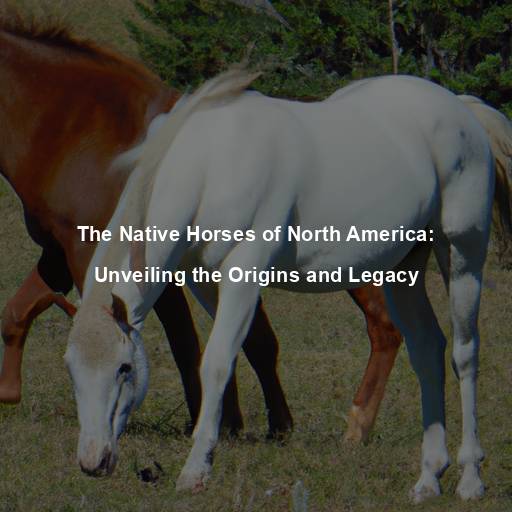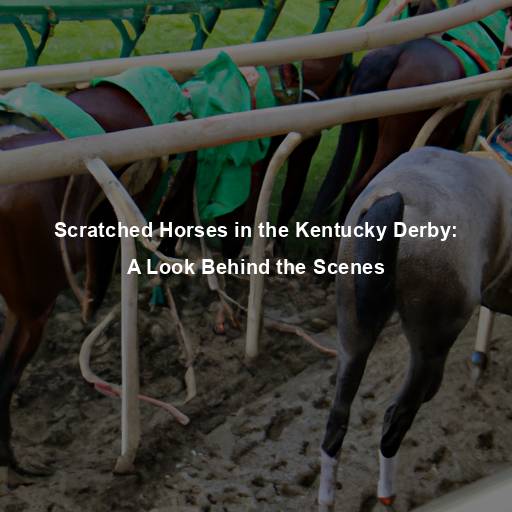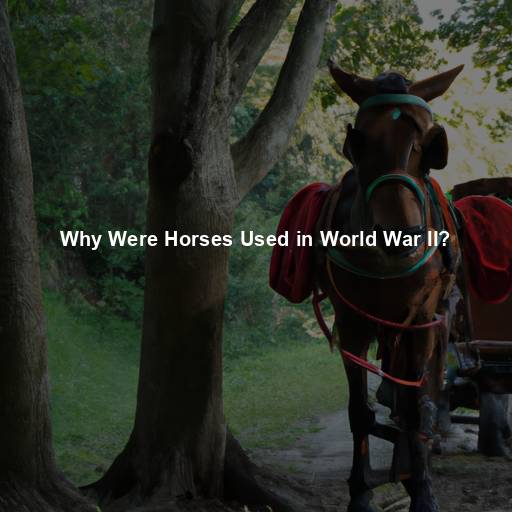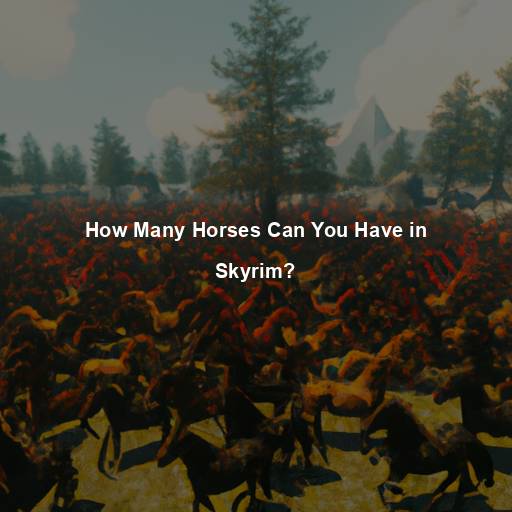The Native Horses of North America: Unveiling the Origins and Legacy
Last Updated on November 4, 2023 by Evan
Contents
- 1 Unraveling the Mysteries of North American Horses
- 1.1 The First Hoofprints: The Arrival of Horses in North America
- 1.2 A Tale of Two Continents: The Spanish Connection
- 1.3 A New Era: Horses and Native American Cultures
- 1.4 The Mustangs: Symbols of Freedom and Resilience
- 1.5 Conservation Efforts: Preserving Heritage and Biodiversity
- 1.6 A Timeless Bond: Humans and Horses
- 2 Unveiling the Origins and Legacy: Exploring the Native Horses of North America
- 2.1 The Genetic Legacy: Tracing the Ancestry of North American Horses
- 2.2 The Spanish Conquistadors: A Fateful Reunion
- 2.3 The Native American Transformation: Horses and Cultural Evolution
- 2.4 Mustangs: The Wild Legacy of Spanish Horses
- 2.5 Preserving Heritage: Conservation and Future Challenges
- 2.6 The Timeless Bond: A Legacy that Endures
- 3 FAQs – Where are Horses Native to North America?
Unraveling the Mysteries of North American Horses
In the vast tapestry of North American history, few creatures have left as indelible a mark as the noble horse. These majestic creatures have been revered for their strength, agility, and unwavering loyalty. But have you ever wondered where horses originated in North America? Join us on a captivating journey as we delve into the origins and legacy of the native horses of this magnificent continent.
The First Hoofprints: The Arrival of Horses in North America
It’s a captivating twist of history that often eludes common knowledge: horses, the majestic creatures we associate with the wild west, were not indigenous to North America. Rather, their ancestors embarked on an epic migration during the enigmatic Pleistocene epoch, joining a host of other iconic animals. Astonishingly, these early equine pioneers vanished from the continent some 10,000 years ago, leaving an equestrian void that was only filled with the arrival of European explorers. The resounding hoofbeats of horses once again echoed across North American soil, marking an intriguing chapter in our shared past.
A Tale of Two Continents: The Spanish Connection
The captivating tale of how horses made a remarkable comeback in North America unfolds with the arrival of the intrepid Spanish conquistadors in the 16th century. Venturing across vast oceans and uncharted territories, the likes of Hernán Cortés and Francisco Vázquez de Coronado undertook audacious expeditions that would leave an indelible mark on the New World. In an unexpected twist, their loyal equine companions also played a pivotal role, forever transforming the ever-evolving landscape of North America. Brace yourself for a fascinating journey through time as we unravel the captivating chronicles of these majestic creatures and their perplexing resurgence.
Throughout history, the majestic Spanish horses, renowned for their indomitable spirit and innate versatility, have left an indelible mark. With breeds like the “Barb” and the “Andalusian,” their enduring strength, agility, and adaptability have become legendary. From the moment the Spanish embarked on colonizing new territories and erecting missions, horses swiftly became essential companions, revolutionizing the existence of the tribes they stumbled upon in ways beyond imagination. Easing the facilitation of exploration and commerce, these robust equines served as catalysts for unprecedented cultural transformation and perplexing encounters between the conquerors and the indigenous peoples.
A New Era: Horses and Native American Cultures
The winds of change blew fiercely across the vast landscapes of North America when horses made their grand entrance. It was as if the very fabric of existence rippled with excitement and awe. The Native Americans, especially those belonging to the Plains tribes, embraced these majestic creatures with open arms, their hearts beating in synchrony with the powerful gallop. With the arrival of these equine marvels, a profound metamorphosis unfurled, unraveling a tapestry of perplexity and wonder.
The Comanche, Sioux, Cheyenne, and many other tribes quickly became skilled equestrians, mastering the art of horseback riding and developing a deep bond with these magnificent animals. The horse became an integral part of their cultural identity, influencing their traditions, art, and even warfare strategies.
The Mustangs: Symbols of Freedom and Resilience
As the tendrils of European settlements stretched further, a magnificent phenomenon unfolded – the untamed horses, born from Spanish origins, found their escape or were relinquished, birthing what we now marvel as the resplendent mustang. These fierce, untethered equines personify the essence of the American West, their unrestrained existence serving as a tangible homage to the indomitable spirit of the Spanish conquistadors. A mesmerizing tapestry woven through time, these wild stallions paint a picture of a bygone era, captivating the curious minds of those drawn to their enigmatic allure.
In the boundless expanse of the American West, untamed and unrestrained, gallops a majestic creature called the Mustang. With its awe-inspiring presence and untamed energy, it journeys through deserts, mountains, and prairies, undeterred by the challenges that lie in its path. This wild symbol of freedom ignites the creative spark in the hearts of many, leaving an indelible mark on the world of art, literature, and cinematic marvels.
Conservation Efforts: Preserving Heritage and Biodiversity
In a rapidly evolving world, a captivating tale unfolds, showcasing the relentless determination to safeguard the vibrant tapestry of North American horses. Dedicated champions, like the American Mustang Foundation and the Bureau of Land Management, emerge from the shadows, their unwavering commitment illuminating the path towards preserving the rich heritage and genetic splendor of these magnificent creatures. With a kaleidoscope of efforts and a symphony of resilience, a brighter horizon awaits, where untamed spirits roam freely, unbroken by the passage of time.
In a world where the fragility of our ecosystems is ever more apparent, it is reassuring to witness the dedicated conservation efforts aimed at protecting not only the genetic heritage of our beloved North American horses but also the intricate tapestry of entire ecosystems they inhabit. These majestic creatures play a vital role in the delicate equilibrium of grasslands, effortlessly shaping habitats for countless species and breathing life into the concept of biodiversity. The harmony they bring, as they gracefully traverse the lands, is a testament to the remarkable and awe-inspiring connections that exist within nature.
A Timeless Bond: Humans and Horses
Throughout history, the bond between humans and horses has transcended cultural barriers and stood the test of time. Whether it be the Native Americans relying on horses for survival, cowboys herding cattle on the open range, or equestrians competing in Olympic events, horses continue to captivate our hearts and enrich our lives.
The captivating tale of North America’s indigenous equines paints a vivid picture of their precarious existence, teetering on the brink of annihilation before experiencing a miraculous resurgence. Their tenacious spirit, intertwined with the fabric of horse lovers’ adoration and the captivating chronicles of the continent, lingers in the collective consciousness. A testament to the indomitable power of these magnificent creatures, they remind us of the intricate threads that connect us to our past and shape our present.
Unveiling the Origins and Legacy: Exploring the Native Horses of North America
Delve into the riveting tapestry of North American horses as we embark on a mesmerizing journey through time. Uncover the enigmatic origins that birthed these majestic creatures, tracing their hoofprints that tell tales of a bygone era. Prepare to be captivated by the profound influence they wielded upon indigenous cultures and the transformative effect they had on the vastness of the American West. Join us as we untangle the intricate threads that connect these creatures to history, revealing the indelible mark they left upon this remarkable continent.
As we celebrate the legacy of these magnificent creatures, let us also recognize the importance of preserving their genetic diversity and the ecosystems they inhabit. The conservation efforts undertaken today ensure that future generations will continue to be captivated by the noble spirit of the horses that roam the landscapes of North America.
Prepare to be captivated by the captivating story of the native horses of North America as we delve into their awe-inspiring origins and everlasting connection with humans. From the sprawling open plains to the heart-stirring experience of horseback riding, these magnificent creatures have woven an intricate tapestry of history that bewitches and beguiles. Join us as we embark on an exploration filled with bursts of enlightenment and perplexing insights, unmasking the profound impact these remarkable beings have had on our lives.
The Genetic Legacy: Tracing the Ancestry of North American Horses
Embarking on a journey to unravel the enigmatic roots of native horses in North America unveils a realm of compelling genetic heritage. Leaping into the depths of extensive research and profound genetic studies, we enter the realm where scientists have unlocked the labyrinthine mysteries surrounding these awe-inspiring creatures. The tapestry of their ancient lineage shimmers before our inquisitive gaze, weaving a tale of captivating complexity and elusive origins. As each layer of their enigmatic ancestry is peeled away, a perplexing pandemonium of ancestral whispers emerges, painted with a kaleidoscope of vibrant hues and breathtaking surprises.
The Ancestors: The Evolution of Equines
Long, long ago, in the depths of time, a curious creature roamed the ancient lands. A diminutive marvel, similar in size to a pint-sized pooch, this fascinating being was known as Eohippus or Hyracotherium. With the passage of eons, these early equines embarked upon an incredible journey of transformation and exploration, adapting to the ever-changing landscapes of our vast planet.
One branch of the equine family tree ventured into North America during the Eocene epoch, giving rise to several species. These ancient horses, such as Mesohippus and Miohippus, roamed the lush landscapes of North America, adapting to changing climates and evolving into larger and more robust forms.
The Disappearance: Farewell to North American Horses
Despite their long history on the continent, the native horses of North America disappeared from the region around 10,000 years ago. The exact reasons behind their extinction remain a subject of scientific debate. Some theories suggest that climate change, habitat loss, or competition with other large herbivores played a role in their demise.
Interestingly enough, the disappearance of native horses from North America did not mark the end of their story. Instead, their legacy continued to unfold across distant lands, where their descendants flourished in unforeseen corners of the globe, like Asia and Europe. At first glance, this peculiar turn of events might leave one questioning the enigmatic threads that connect past and present, reminding us of the bewildering twists that history often takes. Nonetheless, it is a testament to the resilience and adaptability of these remarkable creatures as they navigate the tapestry of time with an air of enigma.
The Spanish Conquistadors: A Fateful Reunion
In a bold and daring chapter of history, the Spanish conquistadors embarked on their audacious voyages to the New World. Little did they know that these journeys would not only reshape continents but also reignite a riveting relationship between horses and the vast, untamed landscapes of North America. It was a momentous reunion, where hooves once again thundered across the prairies, blending untamed beauty with the enigmatic allure of the unknown. The reintroduction of these majestic creatures, spurred by the conquistadors’ ambition, brought about a perplexing yet enthralling burst of life to a land brimming with endless possibilities.
The Arrival: Horses Return to the New World
In the early 16th century, Spanish explorers, driven by the desire for wealth and glory, set sail for the shores of the New World. Among their ranks were skilled horsemen and their trusty steeds, who would forever alter the course of North American history.
In the annals of history, a captivating tale unfolds as the brave Hernán Cortés and his valiant Spanish conquistadors ventured into the realms of the mighty Aztec Empire. Their audacious expedition would serve as a catalyst for a momentous shift, forever altering the course of events on the land we now call Mexico. Amidst this grand upheaval, an unlikely protagonist emerged, none other than the gallant horse. With their indomitable spirit and unmatched adaptability, these majestic creatures etched their hoofprints alongside the conquerors, setting the stage for a truly extraordinary epoch in the annals of horse-human interaction on the American soil.
The Spanish Horses: Barbs, Andalusians, and a Legacy
When the Spanish conquistadors embarked on their epic voyages, they carried with them an enigmatic treasure, not of gold or jewels, but of two captivating equine breeds: the Barb and the Andalusian. These majestic creatures, with their inherent qualities of unwavering endurance, graceful agility, and formidable strength, were carefully chosen and meticulously bred to adapt to the diverse landscapes they would encounter. As their hooves touched foreign soils, these enigmatic steeds became an integral part of the tumultuous tale of conquest and exploration.
Imagine a majestic breed of horses with origins in the vast expanse of North Africa. These remarkable creatures, known as the Barbs, possess an unparalleled combination of speed and endurance, making them the perfect companions for long and arduous journeys and even military expeditions. On the other hand, let’s delve into the enchanting realm of the Andalusians, horses that exude an aura of elegance and grace. These magnificent creatures have captured the hearts of many throughout history, cherished for their ability to adapt and excel in various equestrian disciplines.
As the Spanish established colonies and missions across North America, horses quickly became an integral part of their way of life. The Spanish breeds intermingled with the native horses that had survived in the region, resulting in a diverse equine population with a unique genetic legacy.
The Native American Transformation: Horses and Cultural Evolution
When horses first galloped onto the vast canvas of North America, they stirred up a whirlwind of change among the native peoples, especially those belonging to the resilient Plains tribes. With the arrival of these majestic creatures, a seismic shift reverberated throughout their societies, throwing open the doors to uncharted realms of cultural transformation. From their nomadic existence to their hunting and warfare tactics, nothing remained untouched by the perplexing influence of these newfound equine companions. Indeed, the indigenous peoples of the Plains experienced an unprecedented burst of innovation as they rode the wild currents of evolution, forever altering the very fabric of their way of life.
The Horse Culture: A New Way of Life
In the vast expanse of Native American culture, the horse emerged as an enigmatic figure, holding within its graceful form a multitude of profound meanings. Beyond being a trusted companion on the arduous paths of travel, the horse embodied a profound synergy with freedom, strength, and a profound bond to the ethereal realm of nature. As these majestic creatures were integrated into the tapestry of tribal existence, a profound transformation rippled through the very fabric of Native American life, birthing hitherto unexplored avenues for hunting, trade, and a ceaseless thirst for exploration.
The Plains tribes, in particular, embraced the horse with great enthusiasm. Equipped with horses, they could now hunt bison more efficiently, expanding their food sources and enabling the growth of their populations. The horse became a symbol of prestige and wealth, leading to the rise of powerful horse-owning chiefs and warriors.
Equestrian Mastery: A Bond Between Humans and Horses
Throughout history, the Native Americans grew to possess an extraordinary prowess in the realm of horsemanship, forging an unbreakable connection with these majestic animals. This profound bond with the equine world not only shaped their cultural identity but also left an indelible mark on their customs, rituals, and artistic expressions. The presence of the horse became an integral thread intricately woven into the rich tapestry of their traditions, casting a spell of fascination and perplexity upon those who beheld the symbiotic relationship they shared.
From the tender stages of youth, children delved into the art of equine navigation, embracing the subtle dance between rider and steed. These refined equestrian finesse elevated tribes to new heights of distinction, entwining a profound sense of honor. Horses were more than mere conveyances, for they forged an ethereal bond betwixt humans and beasts, amplifying the ethereal clamor in rituals and enigmatic ceremonies.
Warfare and Diplomacy: The Impact of Horses on Tribal Relations
The arrival of horses had an astonishing influence on intertribal connections and the intricacies of warfare. Surprisingly, tribes fortunate enough to possess a robust equine presence experienced a profound military edge, leading to the expansion of their territories and a palpable sway over neighboring tribes. The unforeseen ramifications left other communities in a state of bafflement and forced them to reassess their own strategies for survival.
Horse-mounted warriors, such as the renowned Comanche and Sioux warriors, revolutionized warfare on the Great Plains. They could cover vast distances, launch swift attacks, and evade pursuers with ease. Horses became indispensable in intertribal conflicts and shaped the power dynamics among Native American groups.
Mustangs: The Wild Legacy of Spanish Horses
As European settlements expanded across North America, horses bred by the Spanish escaped or were released into the wild, laying the foundation for the iconic mustangs of the American West.
The Mustangs: Symbols of Freedom and Resilience
Incredible and awe-inspiring, Mustangs are the living legacies of the magnificent Spanish horses that once roamed the vast expanses of the American West. With an unparalleled aura of freedom and an indomitable spirit, these wild beauties defy the odds, embodying resilience amidst the harshest terrains. Through their adaptability and untamed allure, Mustangs have triumphed against nature’s perplexing challenges, etching their remarkable tales in the annals of time.
With their unrivaled allure, Mustangs have galloped their way into the hearts of admirers as esteemed emblems of the untamed American West. The sheer magnitude of their presence has effortlessly stirred the creative souls of artists, writers, and filmmakers, who relentlessly seek to encapsulate their true essence. Mesmerizing all who cross their path, these majestic creatures symbolize the lasting imprint left by the legendary Spanish conquistadors, shrouding them in an enigmatic aura of power and grace.
Preserving Heritage: Conservation and Future Challenges
As North American horses face a multitude of obstacles, tireless endeavors are being made to safeguard their genetic diversity and protect their invaluable cultural heritage. With a sense of urgency, dedicated individuals are working tirelessly to navigate the perplexing complexities that surround these majestic creatures. As they strive to unravel the mysteries and preserve the very essence of North American horses, their unwavering commitment and intense burst of passion forge a path towards a future where these magnificent creatures can thrive.
Conservation Efforts: Protecting Wild Horse Populations
Dedicated entities, like the American Mustang Foundation and the Bureau of Land Management, tirelessly dedicate themselves to safeguarding the enigmatic and awe-inspiring wild horse populations. Their unwavering dedication stems from a deep-rooted commitment to preserve these majestic creatures, orchestrating robust strategies to uphold their genetic diversity. Through their relentless efforts, they champion the survival and sustained well-being of these captivating equine beings.
Conservationists strive to strike a delicate balance between preserving wild horse herds and managing their impact on ecosystems. Through responsible herd management, genetic monitoring, and adoption programs, they aim to secure a sustainable future for North American horses.
Educating and Engaging: Raising Awareness about Native Horses
Education plays a vital role in fostering an appreciation for the native horses of North America. By raising awareness about their origins, cultural significance, and conservation needs, we can inspire future generations to become stewards of these remarkable creatures.
Through public outreach programs, educational initiatives, and partnerships with Native American communities, we can ensure that the legacy of North American horses continues to be celebrated and protected.
The Timeless Bond: A Legacy that Endures
The breathtaking saga of North America’s native horses is a turbulent tale of peril and triumph, as these majestic creatures teetered on the brink of oblivion, only to rise again like a phoenix from the ashes. Their indomitable spirit and timeless grace continue to captivate the hearts of passionate horse aficionados, while also weaving themselves into the very fabric of North American history, painting a vibrant picture of resilience and enduring legacy. This enduring story of survival and revival serves as a constant reminder of the profound impact that these awe-inspiring animals have had on our collective consciousness, inspiring us to cherish and protect these magnificent creatures for generations to come.
In awe of these majestic beings, we are reminded of their grandeur, power, and allure. We must not overlook the critical need to safeguard their genetic legacy and protect the intricate ecosystems they call home. North America’s horses have etched an indelible imprint on the very fabric of this continent – a legacy spanning centuries, resonating through our history, culture, and sprawling landscapes. It is a tale that unveils the profound connection between mankind and the animal kingdom, exemplifying the unwavering tenacity and resolute freedom that intertwines our destinies.
So, the next time you witness a mustang galloping across the open range or feel the exhilaration of riding a horse, remember the intricate history and profound legacy of the native horses of North America.
FAQs – Where are Horses Native to North America?
Where did horses originate in North America?
Did you know that the majestic horses we adore actually trace their roots back to North America? Astonishingly enough, they emerged around 55 million years ago and swiftly galloped across the entire continent. Fascinatingly, these early equine progenitors, called Eohippus or Hyracotherium, were diminutive in comparison to their contemporary counterparts, sporting multiple toes instead of the iconic hooves we associate them with today.
Did horses become extinct in North America?
Yes, horses became extinct in North America around 10,000 years ago. It is believed that the disappearance of horses from the continent was due to a combination of climate change and overhunting by early human populations. For several thousand years, there were no horses in North America until they were reintroduced by European explorers and colonists in the 16th century.
When were horses reintroduced to North America?
In the vast tapestry of North American history, an unexpected chapter unfolded with the arrival of Spanish conquerors in the 1500s. These audacious explorers, bearing the treasures of their distant lands, also brought with them magnificent equine companions. In a remarkable twist of fate, the hooves of these majestic creatures forged a new path across the continent, multiplying and galloping into the hearts and lives of Native American tribes who encountered them. The consequences were profound, as the tapestry of indigenous cultures intertwined with the enigmatic allure of these newfound companions, forever altering the course of their existence.
Are there any wild horses in North America today?
Yes, there are still wild horses in North America today. These horses are descendants of the domesticated horses brought by the Spanish and subsequently escaped or were released into the wild. The most well-known population of wild horses in North America is found in the western United States, particularly in states like Nevada, Wyoming, and Montana. These horses are protected by law and managed by various government agencies.
Are there any native horse breeds in North America?
No, there are no native horse breeds in North America. All horse breeds found in North America today are descendants of domesticated horses that were introduced by Europeans. However, there are several horse breeds that have developed in North America, such as the American Quarter Horse and the Appaloosa. These breeds have unique characteristics and are highly valued for various purposes, including ranching, rodeo, and recreational riding.







